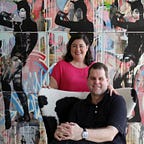The Connor Brothers: Art-world fakery that’s as ‘real’ as it comes
Our artist of the week: The Connor Brothers
Art has always asked us tough questions about where truth ends and where artifice begins — and indeed, whether there can or should be a boundary at all. However, in an era of obsessive social media use, competingcultural narratives, ‘fake news’ and post-truth, it is a matter that may have never been more pressing for our world.
It is into such a troubled void that The Connor Brothers have stepped — and are already enjoying staggering commercial success and cultural currency. But in the case of this once-mysterious duo, it is now a little easier to separate fact from fiction — or at least, that may seem so on firstinspection.
Are you confused yet?
Well, allow us to muddy the waters just that little further. You see, The Connor Brothers rose to prominence as something a little more than met the eye. No one was reallysure what wasbehind the facade tobegin with — just that there was a facade, which the art world loved.
We aren’t just talking about the works themselves with which they made their name, their motifs drawn from popular and historical culture such as Mills & Boon paperback covers, and bearing such thought-provoking slogans as “I drink to make other people more interesting”, “Tell me beautiful and untrue things” and “We must be careful about what we pretend to be”.
Nonetheless, such mottos may also appear to be ruminations on The Connor Brothers’ own once less-than-truthful story. The blurb was formerly that the brothers in question — the twins Franklyn and Brendan — had been raised within a secretive and extreme Christian cult called ‘The Family’ that served to shield them from the mainstream media and other information in the outside world.
Continually blurring the lines between fact and fiction
The cult certainly is a thing — it was startedin the late 1960s in Huntington Beach, California, and the likes of actress Rose McGowan, musician Christopher Owens and the actors River and Joaquin Phoenix were all brought up within it.
However, the Connors were not among them. As a consequence, nor did the associated claims made for them — that they had escaped to Brooklyn as 16-year-olds, and subsequently began to create artworks that enabled them to make some sense of their new and intimidating world — have any veracity.
The reality, though, is probably rather more interesting. So successfully had the pair enchanted and intrigued the art world by 2014, that their works were already selling for thousands at the big auction houses like Bonhams and Christie’s, alongside such much more established artistic titans as Banksy and Damien Hirst. Galleries in London, Los Angeles and Sydney had also already put on several sold-out shows of their work.
So, what changed?
Well, the assumed identity of primitives struggling to get to grips with an unfamiliarWestern society — and becoming almost accidental auction superstars in the process — was becoming too much of an encumbrance. The ‘brothers’ were actuallytwo London art dealers, Mike Snelle and James Golding, although their true stories in many ways seem more outlandish than their long-adopted image.
As detailed in an exclusive interview with the artists featured in The Telegraph in October 2014, Snelle had suffered from lifelong suicidal feelings andGolding was a one-time heroin addict, and the pair beganto work together on their creative pursuits as a form of therapy. The invented identity of the Connor Brothers was a cloak to cover the ‘shame’ of the reality of their respective lives,and to protect themselves from public exposure.
However, the ‘validation’ provided to the duo by their subsequent success led them to throw off their anonymity — and it’s been more than a liberating experience for them. Indeed, the intrigue of their‘double story’ has served to drive theirsales even higher, and pose even more pertinent questions to us all about what we can deem to be real or fake.
As Snelle has observed, it is the paradoxof art that artifice often provides the best means by which to portray reality, while fiction is the best way to challenge conventional ideas of what we perceive to be the ‘truth’. What you think you see,and perceive to be self-evident, isn’t necessarily so. There is so often a deeper or even completely different truth to be ascertained — or to put it in Snelle’sown words, “Who knows the truth of anything?”
At Addicted Gallery the truth is that we love The Connor Brothers, and we certainly don’t need a drink to make these guys more interesting!
